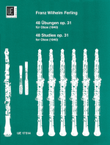Chamber Music flute, piano
SKU: CF.WF119
Based On The Etudes Of Franz Whilhelm Ferling. Composed by John Walker Franz Ferling. Edited by Amy Porter. Arranged by Cyrille Rose. Sws. Back To School. Methods And Studies. With Standard notation. 44 pages. Carl Fischer Music #WF119. Published by Carl Fischer Music (CF.WF119).
ISBN 9780825885372. UPC: 798408085377. 9 x 12 inches.
The popular 32 Rose Etudes have long been a staple in the teachingrepertoire for the clarinet. Now for the fi rst time, they have been adaptedfor use in the study of the fl ute by prominent fl utist and professor of fl ute atthe University of Michigan Amy Porter. These musical etudes have beencarefully edited by Ms. Porter to fi t nicely within the range of the fl ute andhelp to improve the range of developing students. As an added bonus,this book comes with a CD that contains audio MP3 fi les and printable PDFsof piano accompaniments that were composed by pianist/composerJohn Walker to enhance the etudes and make them more pleasing topractice. These etudes are a welcome addition to the fl ute repertoire andwith the included piano accompaniments the etudes can be performedon recitals or juries as well. It is something new that every serious studentor teacher of the fl ute will want to have in their collection.
The Thirty-two Etudes by Cyrille Rose (1830–1903) are toclarinetists what the Twenty-six Selected Studies of JosephHenri Altes (1826–1895) are to flutists. They are an indispensiblemethod of wind playing for musicians to learn phrasing,to incorporate implied harmonic contrasts in solo playing, andto understand the finesse and control of the air stream. Theyare based largely on the Forty-eight Etudes for Oboe, Op. 31by Franz Wilhelm Ferling (1796–1874). Rose transcribed themidiomatically for clarinet, keeping the spirit of Ferling’s etudes,but occasionally altered the key, melody, articulation andphrase markings to fit the student clarinetist.Flutist Altes and clarinetist Rose were colleagues as teachersin the Paris Conservatoire as well as alumni, Altes receivingFirst Prize in 1841 under the tutelage of Tulou (another flutistcomposer)and Rose in 1847 under the tutelage of Klosé. Theiretudes were major influences on the birth and development ofthe then-modern Boehm-system flute and the Boehm-systeminspiredBuffet clarinet. Altes wrote his Complete Method forFlute that include the twenty-six etudes as well and composeda helpful duet part for the flute teacher. For clarinetists, Roseleft it to the performer to interpret the accompaniment, and afew composers have done that in modern times by producingarrangements for clarinet and piano and for clarinet duo.From the time they were written to the present day, clarinetistsaround the world have held these studies in high regard.They were taught during a time when music was transformingthe world through opera, orchestra and ballet, and Rose wasxa0inspired to train the student for the orchestral working environsof the time. Written in the order of C Major, A Minor, G major, EMinor, F major, D Minor, D Major, B Minor, B? Major, G Minor,A Major, C Minor, E? Major, C Minor, E Major, B Major, and D?Major, the etudes are designed to help the performer masterthe inherent technical issues in each key, demanding properintonation, phrasing and attention musical details and gestures;moreover, each key features an etude in a slow tempoand in a fast tempo. However, there are very few markings toguide the student in the style in which they should be played,so it is advised not to play them before the student is ready toplay with musicality and skill.To flutists, I advise studying these etudes repeatedly andlistening for the connection of the notes with the finger movement,not just concentrating on fast flute technique. Listen tothe control of your airstream throughout the middle register,avoiding the common pitfalls that occur in the middle octaveof the flute, such as an unfocused tone and sharp pitch. Makesure your interpretation is based on the overall arching of thephrases, not just on tempo. Breathing is also a challenge to theflutist, since many of the phrases are not evenly measured andgreat care is needed in choosing where to breathe. As theseetudes are written for the range of the clarinet and based onthe range of the oboe, I have chosen to raise the octave placementin some of the etudes to make the etudes more suitedfor all the octaves of the modern flute. Remember that in thismusic, accidentals carry through the measure.





















































